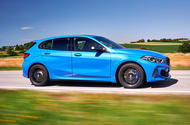Fastest BMW 1 Series is quick and accomplished but lacks the character of the old M140i
Essentially, it’s the fast flagship of the new BMW 1 Series line-up – and it’s arguably even more controversial than its lower-powered front-wheel-drive siblings. Why? Well, whereas many owners of lesser 1 Series are unlikely to notice whether they are being pushed or pulled, those who bought the old M140i (the sort of customers who are no doubt expected to loyally trade-up) certainly will.To counter this, BMW has fitted the new M135i with a turbocharged 302bhp engine (its most powerful production four-cylinder motor yet) and an enhanced version of its xDrive four-wheel-drive transmission.Read the BMW 1 Series 118d first drive reviewThere’s also bespoke M Sport suspension that has been stiffened and lowered by 10mm, a quicker steering rack and more powerful brakes. All good stuff, then. Let’s start with the engine, which not only delivers 302bhp but also serves up a thumping 332lb ft of torque at just 1750rpm. A development of the brand’s existing 2.0-litre four-pot, it packs a stronger crank and pistons, plus higher-flow fuel injectors. On paper, it pretty much matches the Mercedes-AMG A35 for power and comfortably out-muscles it for torque.Yet arguably it’s that four-wheel-drive transmission that deserves the most attention. At the front, it features a Torsen limited-slip differential, while the back axle is of the hang-on clutch type, allowing power to be sent rearwards in just 250 milliseconds. However, the maximum torque split is 50/50 and most of the time the M135i runs in front-wheel drive, unlike larger xDrive models that work the other way around. Hmmmm. Mated to this system is the familiar eight-speed Steptronic automatic gearbox.The 1 Series is also the first internal-combustion-engined model to benefit from the i3’s ARB traction control. Monitored by the engine’s ECU, it reacts 10 times faster than normal ESP-based set-ups, more precisely controlling the motor’s torque to just keep the wheels from spinning and so reducing the need for time-wasting brake intervention.Suspension changes are limited to a stiffer set-up, with a 10mm-lower ride height (two-stage adaptive dampers are optional and fitted to our test car), while at the front, the subframe gets an extra couple of bracing bars for increased steering accuracy. Speaking of which, the electrically assisted rack features a quicker ratio of 14:1, as opposed to the standard car’s 15:1. Finally, the brake master cylinder is larger for better response and more consistent pedal pressure when the going gets quick.Externally, the M135i is marked out but its subtle bodykit (different bumpers, side skirts and tailgate spoiler), 18in forged alloy wheels and twin exhaust tailpipes. Inside, it’s the usual M Sport treatment of a thicker-rimmed three-spoke steering wheel, high-backed front seats, a smattering of M Sport logos and some natty blue and red stripes stitched into the seatbelts.
Source: Autocar
